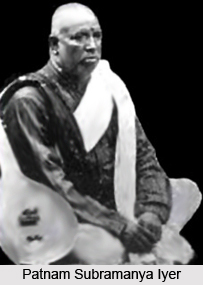 Patnam Subramanya Iyer was Telugu music composer. He was born in Tiruvaiyaru in 1845. Bharatam Vaidyanatha Iyer was his father and his grandfather was Panchanada Sastri. His father was proficient in music and dance and grandfather was the `Astbana vidvan` in the court of Serfoji Maharaja of Tanjavur.
Patnam Subramanya Iyer was Telugu music composer. He was born in Tiruvaiyaru in 1845. Bharatam Vaidyanatha Iyer was his father and his grandfather was Panchanada Sastri. His father was proficient in music and dance and grandfather was the `Astbana vidvan` in the court of Serfoji Maharaja of Tanjavur.
Early Life of Patnam Subramanya Iyer
Subramanya Iyer took his basic music education from his uncle Melattur Ganapati Sastri. Later, he took his further education under the disciple of Tyagaraja, Manambuchavadi Venkatasubbier. The base of his deep musical composition was created by these stalwarts. He got to learn the authentic versions of the Venkatasubbier compositions from him only.
Subramanya had a refractory voice. He used to practice every morning in the early hours in neck deep water to improve his voice quality. His hard work paid and soon he achieved a smooth and melodious voice that danced to his tune. It is said that Subramanya Iyer once went to teach music to the `Pappa` and `Radha`, the two daughters of his admirer, Salem Minakshi at Chennaipatnam. And thus he remained there for almost 10 years. This is the reason that he is known as Patnam Subramanya Iyer.
Life in Music for Subramanya Iyer
Subramanya Iyer was an excellent composer too apart from being a top quality musician. He has composed almost a hundred works, which include varnas, kritis, tillanas and javalis in a wide variety of ragas, talas. All these were written Telugu and Sanskrit. It is said that on listening his composition, `Tirana-dhim-dhim-tirana`, a tillana in the `Jenjhuti raga` at the Mysore `samsthanam`, the king, Chamaraja Wodeyar became very glad. Overjoyed by his composition, the king gifted him a pair of bracelets. This particular song of him fascinated the great violinist, Tirukkodikaval Krishna Iyer so much that from then on, whenever he performed his solo recitals, he used to include this `tillana` invariably in it.
Patnam Subramanya Iyer was also an outstanding performer. He was honoured with the title `Begada Subramanya Iyer` by the Mysore Durbar. It was entitled to him as he sang the raga `Begada` continuously for three days and that was not an easy task for any singer of that time. On some other occasion, at the same Durbar, Subramanya Iyer sang the raga `Kannadagowla` and followed it up with a `pallavi`. This performance by him also won the heart of the Maharaja and he presented him a pair of gold `todas` (bracelets). Another achievement of Subramanya Iyer was his performance of a pallavi in the massive and complex, `Simhanandana` tala.
Subramanya Iyer could grip any kind of raga, whether it is a popular or a rare raga. `Kadianakutuhalam` raga was given a proper shape by him and his composition in this raga is the all-time favourite `Raglmvamshasudhambiidlri`. He had a good grab on various `talas` also, which ranged from the `Adi` tala to the `Jhampa` tala.
Subramanya Iyer took up his guru`s tundra, Venkatesa and variations of the same. Most of his compositions were similar to that of Tyagaraja. According to the specialists, in case of the `mudra` (signature), many of his songs were confused as that of Tyagaraja. Some of his ardent disciples have star status in the area of Carnatic music. These include, Mysore Vasudevacharya, Poochi Srinivasa Iyengar, M.S. Ramaswami and the Enadi sisters. Patnam Subramanya Iyer left this worldly abode on July 31, 1902 leaving behind some talented disciples of him.




